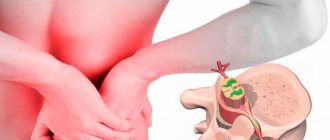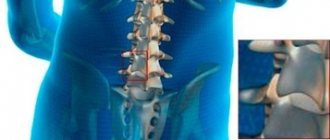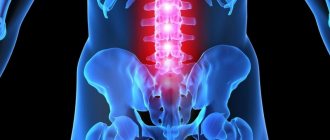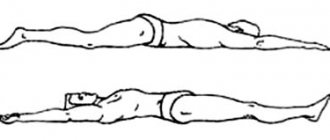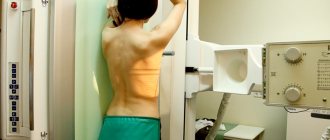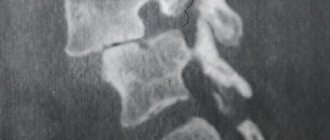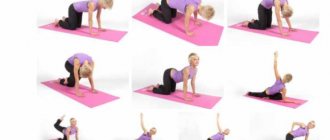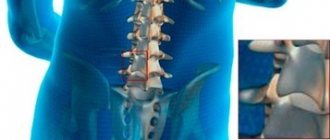Osteochondrosis is a disease of bone and cartilage tissue that most often affects the spine. Osteochondrosis can develop in any part of the spine, including the lumbosacral region. Damage to this area brings significant discomfort to a person and requires immediate treatment, since the degenerative process in the tissues will only progress. Gymnastic exercises are part of the treatment of osteochondrosis and should be prescribed by a specialist. This must be a certified physical therapy instructor or physical therapist who specializes in the treatment of osteochondrosis.
At the Yusupov Hospital, patients receive care from qualified specialists with extensive experience in treating diseases of the musculoskeletal system. A set of exercises is compiled based on the individual characteristics of the person, as well as the degree of damage to the spine. An individual approach to each patient, which is used at the Yusupov Hospital, allows us to achieve maximum results in the treatment of osteochondrosis and significantly improve a person’s well-being.
When is it necessary to do exercises for osteochondrosis of the lumbar spine?
Osteochondrosis is more common in older people, although it is possible that it may develop at the age of 30. Before starting treatment, a diagnosis must be established that confirms osteochondrosis, and not another disease of the musculoskeletal system. It is also important to correctly determine the localization of the pathological process. The details of therapy will depend on this. Diagnosis of osteochondrosis is successfully performed at the diagnostic center of the Yusupov Hospital. Modern equipment allows you to make a diagnosis accurately and in the shortest possible time, which is very important for the timely start of treatment.
Treatment for osteochondrosis will include medication and physical therapy. The use of medications is aimed at reducing inflammation, reducing pain and inhibiting the degenerative process. Physiotherapy is aimed at improving the condition of tissues by increasing blood circulation in the affected area, normalizing metabolic processes, and relaxing muscles. One of the components of physiotherapy is gymnastic exercises for osteochondrosis. They will differ depending on the location of the spinal lesion. For osteochondrosis of the lumbar region, certain exercises are used that have a beneficial effect on this particular area.
Exercises for osteochondrosis of the lumbar spine can only be performed after permission from a doctor. This part of the therapy is as mandatory as taking medications. Without compliance with all components of treatment, it is almost impossible to achieve positive dynamics. The gymnastic complex must be performed regularly, using the exercises recommended by the attending physician. After completing the main course of treatment, the person will need to continue classes to prevent relapse of the disease.
Warm-up and preparation
Before you begin the exercises, you should know that in case of osteochondrosis of the lumbosacral spine, they should be performed sequentially and only after a warm-up, which helps to warm up the muscles. In addition, you need to prepare suitable clothing. The form for exercise therapy must have the following characteristics:
- natural fabric;
- ease;
- thermal insulation.
Exercises should be carried out in a ventilated, warm room, and in case of osteochondrosis of the lumbosacral spine, the lower back should be reliably protected from the cold.
A set of exercises for osteochondrosis of the lumbar spine
Exercise for lumbar osteochondrosis is based on three basic principles:
- exercises should be performed regularly;
- the intensity of exercise increases gradually;
- exercises should not cause pain or overload the muscles.
A set of exercises for osteochondrosis is performed every day for 2-3 months, even when the pain and discomfort have passed. It is necessary to work well on the spine in order to consolidate the positive results of therapy. It is better to continue doing gymnastics further, as this significantly reduces the risk of problems in the spine and improves overall well-being.
Classes for the treatment of osteochondrosis are selected by a specialist. It is very important to take into account all the patient’s characteristics in order to design the most optimal and safe therapy. The specialist monitors the execution of the exercises and monitors the correctness of the patient’s actions. He will point out the intricacies of performing a particular exercise and, if necessary, adjust the chosen type of gymnastics in a timely manner.
Exercises for osteochondrosis of the lumbar region can be as follows:
- stretching of the back muscles. The person lies down on a hard, flat surface, stretches his arms above his head, and straightens his legs. The back is stretched, with the arms stretched in one direction and the legs in the other;
- raising the pelvis. Starting position: lying on your back, arms along your body, legs hip-width apart, bend at the knees, feet resting on the floor. The pelvis is gradually raised, forming a straight line between the knee, hip and shoulder joints. The pelvis also smoothly falls down;
- rotation of the hips in different directions. Starting position: lying on your back, arms perpendicular to the body, legs bent and joined at the knees, feet resting on the floor. The knees smoothly lower to the right, trying to touch the floor, then to the starting position, and to the left;
- spine stretching. Starting position: on all fours, with the hips and floor forming an angle of 90C between themselves; the arms are straight, the wrist, elbow and shoulder joints form a straight line and are also located at an angle of 90C to the floor. The right arm and left leg are extended parallel to the floor, the position is fixed for a few seconds and returns to its original position. Next, the left arm and right leg are extended;
- kitty. Starting position as in the previous exercise. Perform flexion and extension of the spine. As you inhale, the back rounds, the head looks down, as you exhale, the back bends, and the head looks up.
A more complete course of gymnastics is determined individually by a specialist.
Strengthening your back correctly: requirements and recommendations when performing exercise therapy
Where does physical education begin for osteochondrosis of the lumbar spine? That’s right – with high-quality and reasonable preparation for the exercises.
Step 1: Consult a specialist
Only a doctor can establish or confirm the diagnosis of “osteochondrosis” and, most importantly, exclude the possibility of deterioration and contraindications.
Contraindications to exercises for lumbar osteochondrosis may include:
- acute phase of the disease and sharp pains accompanying every movement;
- recent infectious and inflammatory diseases;
- tumors and neoplasms;
- chronic high blood pressure;
- diabetes;
- heart diseases;
- blood supply disorders.
If any of the listed factors are present, consulting a doctor before starting exercises is mandatory!
Step 2. Choose a suitable set of exercises
Most often, for lumbar osteochondrosis, exercise therapy is prescribed in combination with other treatment methods: medications, injections, physiotherapy, etc., but it can also be used independently as prevention or recovery after an exacerbation.
In any case, before starting exercises, discuss the types of gymnastics with your doctor. If you are exercising for preventive purposes, we recommend starting with the simplest complex, gradually increasing the complexity and load and, of course, listening to your own body.
Step 3: Prepare everything you need
To make exercises for lumbar osteochondrosis effective, follow a number of simple rules:
- choose a convenient time for exercise: the key to maximum benefits of physical education is regularity;
- perform exercises in sportswear, giving preference to sets made from natural fabrics;
- do not forget about combining physical therapy with other activities: walking, outdoor games, swimming - schedule time for them too.
Step 4. Be careful when doing exercises
The main task of exercise therapy is to strengthen and restore the body. However, with an unreasonable approach, the opposite effect is also possible. Therefore, it is extremely important to be careful: if pain or discomfort increases, you must immediately stop the exercise, or better yet, inform your doctor or trainer, who will be able to offer a competent replacement.
In addition, when compiling a set of exercises for lumbar osteochondrosis, be sure to include a warm-up and a cool-down: a warm-up will “wake up” the muscles, give them the necessary elasticity and get the blood flowing, and a cool-down will help avoid injuries, muscle overloads and exacerbations.
Exercises for lumbar osteochondrosis: contraindications
There are several situations in which performing exercises with osteochondrosis is contraindicated:
- acute period of osteochondrosis;
- exacerbation of other chronic diseases;
- acute respiratory disease;
- severe form of diabetes mellitus;
- severe form of heart failure;
- high-grade cancer;
- presence of fractures;
- open wounds.
To perform exercises, it is necessary to cure current diseases and eliminate exacerbation of chronic ones.
What is osteochondrosis
Osteochondrosis is a chronic disease of the spine, which is accompanied by changes in the structure (destruction) and a decrease in volume (dystrophy) of the intervertebral discs. They begin to protrude into the spinal cord and compress the blood vessels. Additionally, the disease is characterized by destruction of the facet joints between the spinous processes of the vertebrae.
With osteochondrosis, osteophytes also form. This is the name for pathological growths that are a consequence of marginal bone growth. It is facilitated by impaired calcium metabolism in the vertebrae and high loads that cause their deformation.
Attention! Lumbar osteochondrosis is characterized by all the pathological processes inherent in osteochondrosis in general. But they only affect the lumbar spine, which includes 5 vertebrae.
Exercises for lumbar osteochondrosis: physical therapy in Moscow
High-quality gymnastics for osteochondrosis is carried out at the Yusupov Hospital. This is a multidisciplinary medical institution where they treat diseases of the musculoskeletal system. For the treatment of lumbar osteochondrosis, the patient is prescribed a number of measures that are aimed at improving the condition of the spinal tissues and eliminating or inhibiting the degenerative process. Exercises for the treatment of lumbar osteochondrosis are suggested by experienced exercise therapy instructors, taking into account the individual characteristics of the patient. Classes are held at the rehabilitation center of the Yusupov Hospital, which is equipped with everything necessary for effective gymnastics. In the future, the patient will be able to perform physical exercises at home, but at the initial stage of treatment, the help and supervision of a specialist is necessary. After a course of treatment for osteochondrosis at the Yusupov Hospital, patients note a significant improvement in their condition, the pain goes away, and they can return to everyday activities.
You can make an appointment with rehabilitation therapists, physiotherapists and other specialists, get advice from an exercise therapy instructor, find out more information about the work of the rehabilitation clinic and other questions of interest by calling the Yusupov Hospital.
Preparing for gymnastics
In addition to comfortable clothing that does not restrict movement, exercise may require a thick mat and an elastic cushion that is placed under the knees. Exercise therapy doctors also recommend equipping the room with a special crossbar. Hanging on it for 10-15 minutes helps to increase the distance between the vertebrae and discs, eliminating compression of the spinal roots and blood vessels.
For osteochondrosis of 2 and 3 degrees of severity, clinically manifested by sensitivity disorders, it is advisable to purchase massage mats in specialized stores. Their surface imitates small pebbles, sand, and grass. Performing exercises on such a mat significantly improves the results of your workouts.
Training should be carried out in a ventilated area. It should not be too cool, as low temperatures increase the risk of inflammation of the lower back muscles. And in a hot room, the patient’s well-being may worsen due to lack of fresh air.
Lesson plan, general rules
All exercise therapy exercises for osteochondrosis are divided into three groups:
- performed at the first stage of the acute period (for severe pain);
- performed at the second stage of the acute period (with the easing of pain);
- performed during the period of remission (pain sensations are minimal or even absent).
It is important to strictly adhere to the lesson plan and not mix exercises from different blocks.
You can do physical therapy at any time of the day, the main thing is that an hour or more passes after eating.
When performing the complex, movements should not cause pain. Otherwise, this is a signal to abandon a particular exercise or reduce its amplitude.
To achieve the maximum effect from therapeutic exercises for lumbar osteochondrosis, you must:
- exercise daily;
- perform exercises at a slow pace, concentrating on the work of the muscles;
- remember to breathe correctly;
- Tell your doctor about all results and any questions that arise.
The benefits of therapeutic exercises for chondrosis
Chondrosis is considered the initial stage of a more formidable pathology - osteochondrosis. The causes of destruction of the cartilage tissue of the intervertebral discs have not been fully established. Doctors are inclined to believe that destructive and degenerative changes in cartilage occur due to excessive physical exertion and natural aging of the body. If chondrosis is not treated, then after a few years a person is diagnosed with osteochondrosis, which is characterized by destruction of not only cartilage, but also bone tissue. Therefore, immediately after detecting a pathology, doctors begin therapy using therapeutic exercises. What are the benefits of daily physical exercise:
- increasing the functional activity of the entire spinal column;
- improvement of blood circulation in all parts of the spine;
- stimulation of regeneration of cartilage tissue by saturating it with oxygen, nutrients and biologically active substances;
- strengthening skeletal muscles, building up the muscle frame to stabilize intervertebral discs, preventing their displacement and the formation of intervertebral hernias;
- elimination of contractures and stiffness of movements;
- normalization of innervation, elimination of pinching of sensitive nerve endings;
- improving posture, preventing curvature of the spinal column.
The first gymnastics classes should be supervised by a specialist.
Therapeutic exercises are useful for any disease. But if pathologies of internal organs respond well to treatment with pharmacological drugs, then this method in the treatment of chondrosis does not give a noticeable result. No drugs have yet been synthesized that can completely restore damaged cartilage. But regular training in the initial stages of chondrosis stimulates their regeneration by accelerating metabolic processes.

